Rhinos: Culture, Colonialism and Conservation
The natural world is filled with a huge variety of colours and patterns, from the shimmering iridescent blues, reds and greens of the Madagascar sunset moths to the striking orange of the Guianan cock-of-the-rock. These arresting natural colour palettes may seem the perfect inspiration for artists throughout history, but far more frequently, artists have been drawn to animals not conventionally beautiful, and coming in shades ranging from grey to brown.
Images for this article are taken from the Rhino Resource Center, a terrific reference site for these glorious creatures.
Perhaps most significant among these animal muses is the rhino, whose image has been used by humans from the time of the Chauvet cave paintings in France, roughly 30,000 years ago. Their images have evolved hugely since then, and allow an insight into how our relationships with these animals has changed over time, and how it may continue to change.
The rhino cast of characters
Before going any further, it’s worth discussing the cast of rhinos that are around today, and which have featured in art throughout history. There are five living species of rhinos: two in Africa and three in Asia. All of them are under threat as a result of human activity.
The white rhino is the largest of the five species and is the most common left today. It lives throughout Africa and is adapted to feed on grass. They are a real conservation success story, having recovered from around 20 individuals early in the 20th Century to be at c.18,000 individuals today. They are the only rhino species not considered to be threatened by the IUCN (International Union for the Conservation of Nature). At first sight, the black rhino looks superficially similar, though there are some key differences. This species feeds on browse (leaves and twigs) and so has a pointed lip to help it grasp leaves. Some people think this difference in the mouth shape might be how the two species got their names. The white rhino has a square mouth, and when local people were describing it, they used the Afrikaans word ‘wyd’ (meaning wide), which was misinterpreted by Europeans as ‘white’. Serendipitously, black rhinos do tend to have a marginally darker colour.
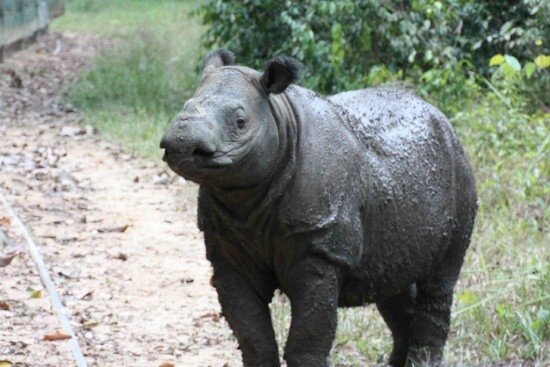
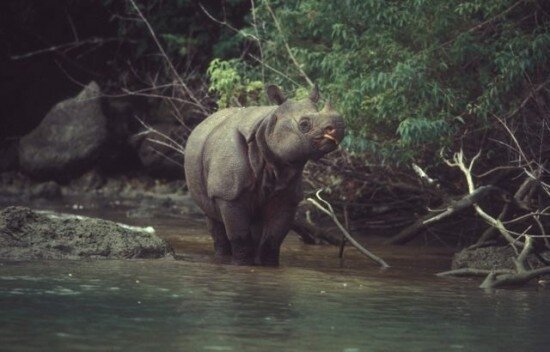
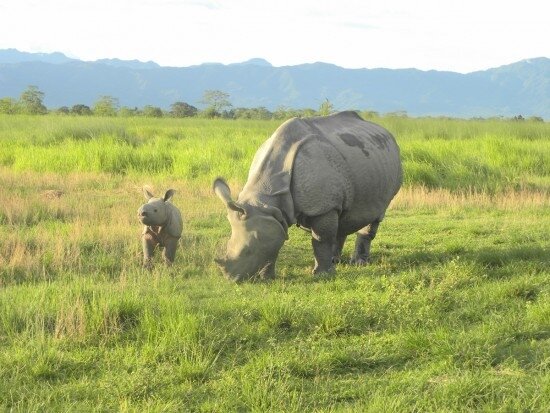
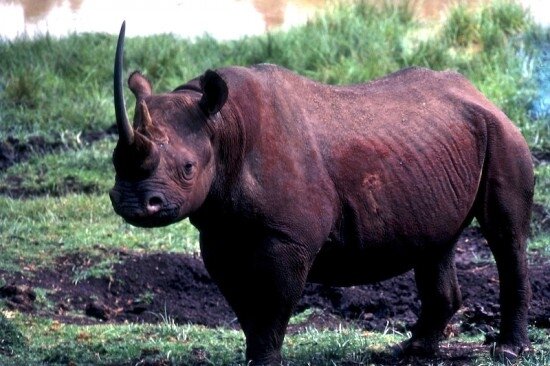
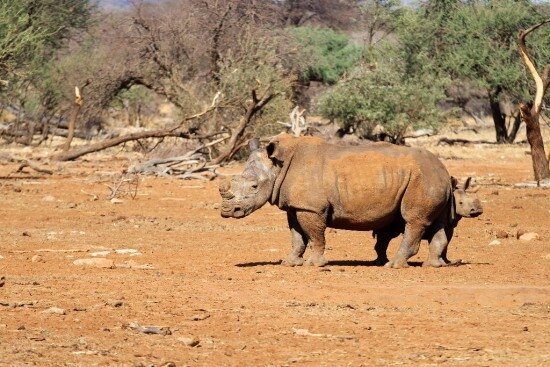
The largest of the Asian rhinos is the Indian rhino. In contrast to the African species, it has only one horn, and it is covered in thick, folded skin, which resembles armour. This species lives in the grasslands of India and Nepal, and again has a lip which allows it to browse, though the majority of its diet comes from long grasses. The other two Asian species, the Javan rhino and the Sumatran rhino are vying for the unfortunate title of the rarest large mammal in the world, with both populations well under 100 individuals. The Javan rhino very closely resembles the Indian rhino, though is considerably smaller. It is found in only a single national park, close to an active volcano, but the population does seem to be slowly expanding, and there have been recent reports of births. The Sumatran rhino has not fared so well. It is covered with a layer of reddish-brown hair and has two tiny horns. This is the most ancient rhino species, more closely related to the extinct woolly rhino than any modern species, and they are by some way the smallest. They are solitary, wandering around the forests, singing with their almost bird-like voices. Sadly, they are now so rare that they almost never answer each other’s calls.
Rhino Pioneers
Whilst ancient cave paintings and clay sculptures suggest that rhinos have been a part of the global consciousness for many thousands of years, their appearance in mainstream art came significantly later, in 1515. It was in this year that the King of Portugal sent a single Indian rhino to Pope Leo X as a gift. The ship carrying the animal sadly crashed off the coast of Italy, but not before an artist had drawn a very rough sketch. Albrecht Dürer used this sketch, as well as some contemporary writings, to produce an image of the rhino, ornately covered in armour plates, and sporting a second horn between its shoulderblades.
Rhinocerus,
woodcut'
dated 1515. A 16th century meme.
Albrecht Dürer / Public domain
Dürer, a canny opportunist, made a woodcut of the animal, which coincided almost perfectly with the invention of the Gutenberg printing press. Woodcuts can be much more efficiently copied and as a result, the image of this fantastical beast spread around Europe, and entered the imagination of artists throughout the continent, who had seen nothing like it. Reproductions of the print were made until the 18th Century, and the image, thought to be a realistic likeness, was recreated even in renaissance pieces.
Dürer’s image of this armoured monster persisted for several hundreds of years, until the transport of live individuals became more popular, particularly for menageries. These travelling rhinos allowed European artists to produce much more accurate depictions, and none more so than another Indian rhino called Clara. She arrived in the Netherlands in 1741 and spent 17 years touring Europe (a long lifespan for captive animals at this time). She could be said to be the first real animal celebrity: during this tour she met royalty, posed for portraits and ‘performed’ at exhibitions. Her influence was so great that the French Navy named a ship Rhinocéros after her, and she was even pictured in the background of a book of human anatomy.
These travelling rhinos, as well as some of the others that appeared in Europe, were all Indian rhinos, meaning that the majority of images from this time are of this species. The graph is produced from images on the Rhino Resource Centre, a collection of over 3000 images of rhinos through time. It demonstrates the early dominance of Indian rhino images, and the peak corresponding to Clara’s arrival in Europe in 1741 is particularly obvious. This ‘rhino blindness’ was due to a complete lack of European understanding during the 18th Century of the diversity of the rhino, demonstrated by the fact that it was only realized that there were two African species in 1780.
Rhinos and the Empire
With the expansion of European empires during the early 19th Century came, finally, an increasing number of images of African rhinos. Sadly, the days of treating the rhinos as a curiosity to be admired and recorded were gone, and the images all too often became a record of big-game hunting. No species suffered this fate more so than the black rhinos, who were versatile and far-ranging, making them easy to find - and easy to hunt. One English captain described seeing 60 in a single day (it is unclear how many of those he shot…), in stark contrast to the sparse numbers of these animals today. The same is true for other species too – the Indian rhinos were the first to be hunted in the name of empire, but they were less valuable than the African species, with their two horns.
The ‘Empire Mentality’ describes the phenomenon whereby white European men travelled to other parts of the world with a perceived right of dominance over other cultures. This truly is a despicable time in European history, one which we have a lot to answer for. The journals of these explorers are horribly racist and don’t bear repeating, but provide us with some insight into the attitudes towards the animals themselves. The Empire Mentality clearly extended to rhinos as a commodity ripe for the taking. Extinction was really only just being discovered by scientists: it had previously been thought that absent animals were just found somewhere else on Earth, and so perhaps the slaughter should not be surprising.
From Hunting to Conservation
It is well understood now that hunting for ivory has been one of the primary causes for the decline of all rhino species. Initially, this was by big-game hunters who pictured the horns above their mantelpiece, and consequently, imagery from the time shows white hunters ‘bravely’ shooting a charging, angry rhino. As is remarked by one of the premier “scientific hunters” of the time however, it is justifiable to react angrily when “woken from a comfortable doze by such a surprise as a 12-bore bullet”. These European hunters set up the Society for the Preservation of the Wild Fauna of the Empire [PDF] in 1902 in a nominal bid to protect the species they hunted. Champion de Crespigny wrote in 1905 that “our grandchildren have to be thought of” [PDF], though it is clear that this was intended to mean that there should be enough big game left so that hunting could continue into the future. There were concerns that the native populations would somehow be more likely to drive extinction of these species... Fortunately, that society has morphed into Fauna and Flora International, a non-profit that does fantastic work globally to protect all species.
The replacement of these hunting images with genuine promotion of conservation came in the mid-20th Century, perhaps corresponding both with the outbreak of successive world wars and the collapse of the European empires. This move towards viewing rhinos as creatures to be conserved has involved much more depiction of them as calm, peaceful animals, often set against a magnificent backdrop. Rhino killing through the 20th Century has more frequently come from poaching, where horns are taken to sell at a profit for traditional medicine. Reducing the consumption of these horns (and thus reducing demand) is the key here, and art has a significant role to play here in changing perception of these animals. One WildAid campaign in Vietnam reduced the number of people who believe that rhino horns have medicinal value by 67% in only three years. Such changes in perception will be key to saving these animals, particularly the two most critically endangered Asian species. Whilst the risk to all rhino species is grave, the huge increase in focus towards conservation in recent years is encouraging. Rhinos have a longstanding and venerable position both in the natural world and in art history, and if we are going to keep them around, we must continue to promote them as a source of awe and wonder, just as they were in 1515.
Editor’s postscript
Cambridge is well known as a cluster of high-tech businesses such as Microsoft, AstraZeneca and ARM; it ought to be equally renowned for being home to the largest cluster of conservation NGOs in the world, including Flora & Fauna International (the former ‘Society for the Preservation of Wild Fauna of the Empire’ cited by Oscar). In this video from April 2013, Sir David Attenborough brilliantly illustrates the history of some of the organisations that have roosted in Cambridge, and now form part of the Cambridge Conservation Initiative. It’s one of the most wonderful speeches you’ll ever hear.
CCI comprises:
• BirdLife International
• British Trust for Ornithology
• Cambridge Conservation Forum
• Fauna & Flora International
• International Union for Conservation of Nature
• Royal Society for the Protection of Birds
• TRAFFIC
• Tropical Biology Association
• UNEP World Conservation Monitoring Centre




